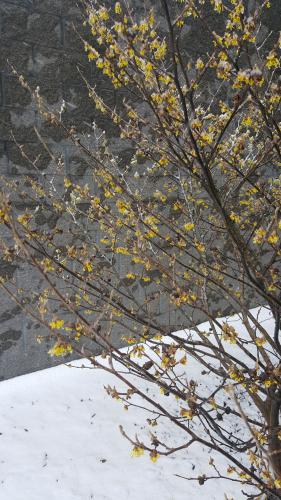Is that a big forsythia?
Witch hazel is the earliest and latest blooming tree of the year.

Travel through any community and you may see large shrubs or small trees that are blooming this time of year — even through the snow. Since it’s even too early for forsythia, what could it be? These attractive curiosities are likely to be a variety of witch hazel.
If you see them blooming in late winter, the variety may be a cultivar or a Michigan non-native witch hazel like Ozark witch-hazel (Hamamelis vernalis). The native species is actually Hamamelis virginiana, and they bloom in the fall after all other plants are finished with such displays. Although the varieties of witch hazel that are not native to Michigan may only be found in neighborhood yards or other landscaped areas, the native species can be found thriving under the canopy of forests throughout Michigan's Lower Peninsula (it is not as abundant in the Upper Peninsula). Witch hazels are usually found in association with oak and hickory on drier sites or growing under mature aspen stands. It’s found less often in richer deciduous forests and is not suited to either wet or more exposed, sunny sites.
Species identification and characteristics
Although the common name has the word ‘hazel,’ it is not related to another shrubby native: hazelnut (Corylus americana). The resemblance between the two species stops with the shape of the leaf, where both have roughly oval leaves with wavy edges. In Michigan, witch hazel does not grow to be very large. The maximum height is usually around 15 feet and is often found with multiple stems. The most distinctive characteristic, as mentioned earlier, is its unusual flowering—both in its season and structure. Four small, short and thin petals of the fragrant blossom are a striking lemon yellow color. Although many nectar-feeding insects may be dormant by late fall or early winter, certain species of nocturnal moths are still active and serve as the main pollinators of these flowers. The shiny black seeds develop over the next year. When mature, these seeds are forcibly ejected from the seed pods, scattering them up to 20 feet across the forest floor.

Hardy witch hazel can blossom through early winter weather.
Cultural and medicinal value
Witch hazel is special for more than just its unique flowering habits. The tree bark contains a combination of tannins and flavonoids that serve as an effective astringent. Many Native American tribes were aware of the plant’s benefits when treating open wounds and various skin afflictions. Compounds from witch hazel are still an important ingredient in many over-the-counter skin creams, washes and soaps. Traditional lore also valued this tree as a source of divining rods to detect underground water sources or dowsing.
Want to enjoy these unique plants in your own woods or yard this fall? This is the perfect time to begin thinking about ordering transplants from a local Conservation District (CD). Many Michigan CD offices throughout the state are currently conducting their annual tree sales. A variety of tree seedlings, including witch hazel, may be available to enhance the structure, functionality and beauty to local landscapes.
There is a right way to plant a tree, so be sure to improve their chances of long-term survival by treating new transplants properly. The Michigan State University Extension bulletin titled "Tree Planting in Michigan" offers the tips and tricks needed for healthy new plantings.



 Print
Print Email
Email




